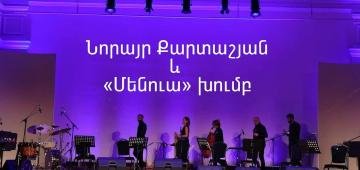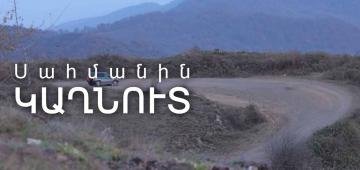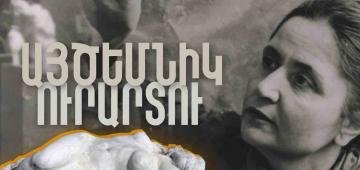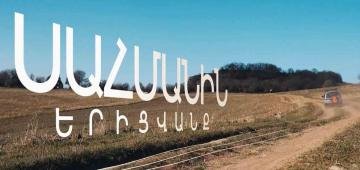 |
Concert program Norayr Kartashyan and Menua BandFestive musical program, various performances, Armenian choral music, Armenian cultural heritage, Armenian musical education, Armenian cultural life, Armenian musical culture, Armenian musical history, Armenian musical heritage, Armenian cultural exchange, Armenian cultural projects, Armenian cultural performances, Armenian cultural preservation, Armenian musical educational programs, Armenian cultural festive programs |
 |
New Year's songThe Khazer Choir performs New Year and Christmas songs. |
 |
Syunik: KaghnutIn Kaghnut, many doors are closed, the village streets are empty. Only twelve of the 105 houses are inhabited. Life here has changed dramatically since the school closed in 1988. The road, which has not been repaired for decades, has isolated the village and multiplied the social and economic problems of the residents. |
 |
Khazer Choir: The Legacy of Komitas: Hayrik MuradyanKhazer Choir, Komitas's Legacy, Hayrik Muradyan Concert, Armenian Choir Music, Armenian Classical Music, Armenian Musical Heritage, Armenian Cultural Events, Armenian Musical Concerts, Armenian Musical Groups, Armenian Cultural Preservation, Armenian Musical Performance, Armenian Musical Culture, Armenian Musical Projects, Armenian Musical Festivals, Armenian Musical Life |
 |
Aytsemnik UrartuThe whole city knew the location of Aytsemnik Urartu's studio, located in the courtyard of one of Yerevan's alleys. She was one of the shapers of Armenia's cultural life, her works adorned exhibition halls and became the subject of study by art historians. Today, the name of the first Armenian female sculptor is known only in narrow professional circles. |
 |
Syunik: YeritsvankThe early medieval Yeritsvank monastery is located on a plateau 3 km southeast of the village of Artsvanik in Kapan, isolated from other settlements. It was founded by the Metropolitan of Syunik, Yeritsak, in the 5th century. The Ministry of Culture, Sports and Tourism and the “Service for the Preservation of Historical and Cultural Reserves-Museums and the Historical Environment” SNCO are conducting excavations in the sanctuary, which has been neglected for centuries. The expedition is led by archaeologist Avetis Grigoryan. |
 |
Syunik: YeghvardBefore the 44-day war, the road from Kapan, the center of Syunik region, to the village of Yeghvard was 12 km long. After the war, that road has almost doubled in length. Now Yeghvard is a border village, surrounded on three sides by Azerbaijani positions like a peninsula. The village, with a population of 250, guards about 17 km of the border. |
 |
"Artsakh" Chamber OrchestraAfter the Armenian exodus from Artsakh in 2003, the Artsakh Chamber Orchestra, like many orchestras and ensembles, found itself in an uncertain state, with its musicians left unemployed. With the help of world-renowned musicians Hasmik Papyan and Narek Hakhnazaryan and with the financial support of the AGBU, the orchestra was reorganized in Yerevan. A new page has begun in the orchestra's life, the key goal of which is to make the name of Artsakh heard on prestigious stages around the world. |
 |
Spyridon MelikyanComposer Spyridon Melikyan left behind symphonic and choral works. As a conductor, he raised Armenian choral art to a new level. As an ethnographer, he saved a great treasury of folk songs from oblivion. As a scholar, he examined the theoretical issues of Armenian music in a new light. The former seminarian’s entire life was a service to Armenian music and Armenology. |
 |
VahanThe border village of Vahan is the northeastern gateway to Armenia. The village borders Azerbaijan for about 27 km. In some parts, the border is only 2-3 km away. The century-old village has had other names in the past. It was founded in 1925 under the name Rubenakert, renamed Ordzhonikidze during the Soviet era, and in 1991 received its current name in honor of the brave eagle of Artsvashen, Father Vahan. |
 |
Ulikhanyan sistersVictoria and Liana Ulikhanyan have been engaged in classical music since childhood. They have already managed to perform on international platforms, participate in festivals, competitions, and have concerts on international stages. In addition to performing arts, the violinist and cellist sisters also create, and a video clip of Victoria Ulikhanyan's piano trio composition "Mechanics of the Sun" was recently shot, with which the girls are trying to popularize classical music. |
 |
Sebastian Teachers' ChoirThe "Sebastatians" teacher's choir has been operating since 2012. The founder of the Yerevan State Chamber Choir, Honored Artist Harutyun Topikyan, was the conductor at the foundation of its formation. It is a four-part, open choir, composed of educators from the educational complex. The choir performs Komitas' spiritual and secular songs, medieval hymns, works by modern Armenian composers, and disseminates them through educational, cultural, and patriotic campaigns-concerts, educational liturgies, and organizing and participating in national rituals-festivals. |